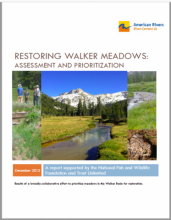Restoring Walker Meadows: Assessment and Prioritization

Purpose:
The purpose of this Walker Basin Meadows Condition Report is twofold. First, it provides condition data and explains why the Walker Working Group chose the first set of meadows as the top priority for restoration. Second, the working group will use information presented here to plan subsequent restoration efforts once the first group of meadows is restored.
Introduction:
Meadows of the Walker River basin are an extremely valuable component of the landscape. Meadows provide diverse habitat, including habitat critical to endangered species. They reduce peak flows during storms and soak up spring runoff, recharging groundwater supplies. Meadows filter sediment, provide forage, and are important cultural and recreational sites. However, the National Fish and Wildlife Foundation (NFWF) estimates that half of all meadows in the Sierra Nevada are degraded and no longer provide these natural benefits (NFWF 2010). Fortunately, there are methods to restore the condition of unhealthy meadows, and investment in meadow restoration is expanding rapidly. Investorsincluding NFWF and other foundations, state and federal agencies, corporations, ranchers and land managersseek to provide the largest return on their restoration investment. Therefore, an important question is which meadows, if restored, will provide the greatest value? To answer this question, American Rivers partnered with the Forest Service and NFWF to develop a scorecard to rapidly evaluate meadow condition and prioritize meadows for restoration (American Rivers 2012). The method has been applied in the Yuba, Mokelumne, Kern, and Tuolumne River watersheds, and assessment is underway in the Carson, Truckee, and American River basins. UC Davis has developed a database to store this “Meadow Scorecard” data (http://meadows.ucdavis.edu/assessments/map). This assessment method has been used to identify dozens of high priority meadows and thereby focused our efforts and accelerated restoration.
Between 2013 and 2015, American Rivers and Trout Unlimited were funded by NFWF to use the scorecard in the Walker basin to guide investment and accelerate the pace of restoration. We assessed every accessible meadow in the watershed that is larger than 15 acres, 30 in all. We identified five priority meadows and established the Walker Working Group to pursue restoration of these five sites as an initial objective.
Meadow restoration is currently the unifying force of the Walker Working Group, but our vision is that the group’s focus will expand beyond these five meadows to improve the health of the watershed and aid in the recovery of the Lahontan Cutthroat Trout and Yosemite Toad. Group members include land managers (Humboldt-Toiyabe National Forest, California Department of Fish and Wildlife and US Marine Corps), non-profit organizations (Trout Unlimited, CalTrout and American Rivers), consultants (Todd Sloat Biological Consulting, Annie Overlin Botanical Consulting), and local agencies (the Mono County Resource Conservation District). The presence of the working group in the watershed has already helped to accelerate the pace of restoration. American Rivers and our partners completed prioritization in 2015, and members of the Walker Working Group have raised $548,000 for restoration of high-priority sites ($378,000 for design and permitting and $170,000 for implementation activities).
Luke Hunt, Julie Fair, Jacob Dyste and Max Odland, 2015. Restoring Walker Meadows: Assessment and Prioritization. A report by American Rivers submitted to the National Fish and Wildlife Foundation.
